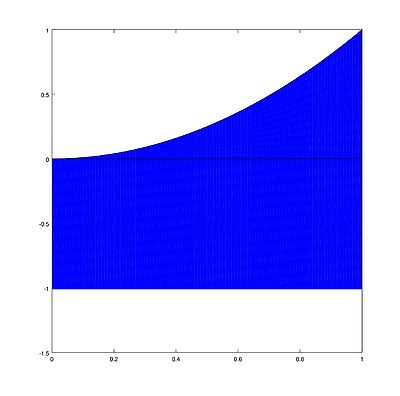Science:Math Exam Resources/Courses/MATH103/April 2014/Question 02 (b)
{{#incat:MER QGQ flag|{{#incat:MER QGH flag|{{#incat:MER QGS flag|}}}}}}
• Q1 (a) • Q1 (b) i • Q1 (b) ii • Q1 (c) i • Q1 (c) ii • Q1 (c) iii • Q1 (d) i • Q1 (d) ii • Q1 (d) iii • Q1 (e) i • Q1 (e) ii • Q2 (a) • Q2 (b) • Q3 (a) • Q3 (b) • Q3 (c) • Q4 (a) • Q4 (b) • Q4 (c) • Q5 (a) • Q5 (b) • Q5 (c) • Q6 (a) • Q6 (c) • Q7 (a) • Q7 (b) • Q7 (c) • Q8 (a) • Q8 (b) • Q9 (a) • Q9 (b) • Q9 (c) • Q10 (a) • Q10 (b) • Q10 (c) • Q11 •
Question 02 (b) |
|---|
|
Let for . Find the volume of the solid generated by revolving (for ) around the horizontal line . Hint: a sketch might help. Work must be shown for full marks. Simplify fully. |
|
Make sure you understand the problem fully: What is the question asking you to do? Are there specific conditions or constraints that you should take note of? How will you know if your answer is correct from your work only? Can you rephrase the question in your own words in a way that makes sense to you? |
|
If you are stuck, check the hints below. Read the first one and consider it for a while. Does it give you a new idea on how to approach the problem? If so, try it! If after a while you are still stuck, go for the next hint. |
Hint 1 |
|---|
|
The region in question is pictured below. The axis of rotation is the bottom edge of the region.  |
Hint 2 |
|---|
|
Just as the region underneath the graph of a function (whose area is the integral of the function) can be subdivided into infinitely many lines, the solid formed by revolving the graph of a function about a line can be subdivided into infinitely many disks (whose radii are given by the height of the graph). |
|
Checking a solution serves two purposes: helping you if, after having used all the hints, you still are stuck on the problem; or if you have solved the problem and would like to check your work.
|
{{#incat:MER CT flag||
}}









![{\displaystyle V=\int _{0}^{1}\pi (x^{4}+2x^{2}+1)\mathrm {d} x=\pi \left[{\frac {1}{5}}x^{5}+{\frac {2}{3}}x^{3}+x\right]_{0}^{1}=\pi \left({\frac {1}{5}}+{\frac {2}{3}}+1\right)={\frac {28}{15}}\pi .}](https://wiki.ubc.ca/api/rest_v1/media/math/render/svg/e5925ad006049c9117c2e5d0e7ac650798bd4038)
